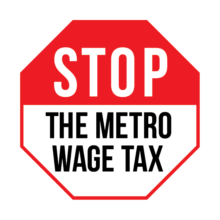The Case Against Metro’s $5 Billion Transportation Bond
By Joe Cortright
Metro’s proposed $5 billion transportation measure makes no sense for the region, for transportation, for our economy, for our kids and for our planet.
Portland’s regional government, Metro, will be asking voters in November to approve a $5 billion transportation bond measure. There’s a strong case to be made that this is a badly flawed approach to the region’s future. Today, we lay out the arguments against this measure.
- The plan is founded on a highway-oriented concept of corridors, rather than a more sensible approach emphasizing walkable centers and main streets.
- The $5 billion measure does nothing to lower greenhouse gases.
- Its wage tax is unrelated to transportation, effectively taxing those who use the system least, and subsidizes those who drive and pollute the most.
- The measure amounts to a 30 cent per gallon gasoline subsidy, encouraging more driving and increasing greenhouse gas emissions 50 times more than the amount saved by all its investments.
- The measure cannibalizes the principal source of funding for transit operations just as Tri-Met is experiencing an operating funds financial crisis.
- The plan is mired in the past, making no allowance for the changes we’ve already experienced in driving during the Covid-19 pandemic.
- Metro’s plan plunges the region into debt for the next two decades, using up funds that will be badly needed to combat climate change.
- This measure makes Portland taxpayers pay for problems created by the Oregon DOT: unsafe and transit hostile state highways.
- A better approach would be to have road users to pay directly for the services they get, reducing carbon pollution, creating a more equitable transportation system.
After a year-long process Metro has sketched out a $5 billion plan, which includes investments in a number of “corridors”—we’ll come back to that term in a moment— and which would be paid for by imposing a .75 percent payroll tax on firms with 25 or more employees, roughly for the next two decades. (For the past fifty years, the region’s transit agency, Tri-Met has subsidized its operations by a similar payroll tax). The plan earmarks funds for a number of projects, most notably another leg of the region’s light rail system, this one to angle to the southwest suburbs. While there are a few set-asides for measures to promote access by low income populations (subsidized transit fares for students), the bulk of the money is allocated to capital construction.
